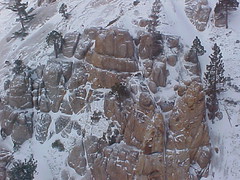Just before the cable car began its journey it rocked slightly when some sort of release was pulled, and a squeal erupted from the fourth graders – but it quickly diminished and then was soon followed by “ahhs†as the car lurched and then smoothly soared from its perch.
The day before I had handed out 5 digital cameras and 2 digital video cameras to the seven groups of students in my room. As they read their SSR books I made the rounds to each group and showed them how to use the camera their group was assigned and had each group member take a trial picture (or video clip). 23 out of 26 students had never used a camera before, but they caught on quickly and were excited about using them to record our journey and get the “landform†pictures we were seeking for our projects.
Cameras emerged from backpacks as we gained altitude, and the student that had been assigned by their group to take photos of our ascent began snapping pictures (click on my Flickr badge on the right side of this page to see over 20 of the 180 total pictures the students took). As the car cleared the first tower, about 1800 vertical feet from where we started, and the car rocked and swayed, a student standing close to me sputtered, “This is so cool!â€
As you cover the final third of the trip to High Camp, granite boulders that were melted into blobs cover the ground below you. The cable car attendant explained that Walt Disney had his artists spend time here sketching and designing how the rocks and boulders would appear on the “Thunder Mountain†ride at Disneyland after he experienced this scene many years before.
At the top we emerged from our car and I noted that we really only had about 30 minutes to make our observations and photos outside and eat lunch before we needed to board the cable car for our trip down the mountain if we were going to keep our bus drivers happy.
The scene outside was amazing. I’m sure many of you would think I’m nuts … and truly I wish the weather had been clear and we would have had the view of Lake Tahoe that is available here … but I loved that the weather was somewhat marginal. The wind was blowing steady at probably 12 to 15 miles per hour and the temperature was 16 degrees. The thick wire fencing around the deck had frosty ice on the side facing the wind that was difficult to break off with my gloved hand. The flags waved stiffly in the wind. I strode out onto the deck and the students followed – cautiously at first, but then flooded the deck and lined the rail. My students traded off who used the camera in their group, as they had pre-arranged, and more pictures and video were snapped. The Olympic rings that adorn the ice rink garnered much attention, as did the swimming pool and spa (see my Flickr badge for sample photos).
About 5 minutes was all that most could take, but they weren’t running into the lodge … they loved it. I stayed out a few more minutes with those that wanted to stay and soak it all in and take more pictures.
While the students ate their sack lunches they were already reminiscing about the experience. After slamming down lunch we quickly caught the next car down … a news crew from Sacramento, there to do a story about the start of ski season, had had the great fortune of making the trip up the mountain with our rabble, and now they had the great fortune of timing their visit so they also joined us for the return trip : ). They got a student to help them by taping him saying some catch-phrase (that I didn’t catch) and he did on the first take so they were all high-fiving him and he was beaming.
All during the trip students were also writing in their “Field Trip Journals†– making assigned observations and gathering impressions that we will turn into poetry and informational paragraphs and captions for some of our photos. Today my class learned how to “word process†the first poem they wrote about the cable car on their laptops, and tomorrow we will grab pictures off of Flickr to illustrate them. Maybe we will even post a few.
Whenever I take a trip like this with my students – I am always reminded why I take trips like this with my students. Some have already mentioned to me how they can imagine how difficult it was for the mountain climbers we read about earlier in the year. This is how I want to do it. Experiences, messy experiences leveraged by tech and science and social studies and art and …
Learning is messy! – and a bit chilly!


 Diatoms, 3500x magnification, taken with scanning electron microscope, University of Nevada, Reno – by John Kevin McCormack
Diatoms, 3500x magnification, taken with scanning electron microscope, University of Nevada, Reno – by John Kevin McCormack